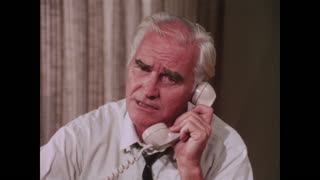“On Guard: Bunco! ” is a film made by the District Attorney County of Los Angeles in cooperation with Evelle J Younger, the California State Attorney General. It was produced by Don Hoster and directed by James Tartan. The film alerts and informs the audience about criminals who prey upon the unwary through fraudulent schemes such as those dramatized.
The film shows the importance of community education and cooperation in fighting crime. It focuses on the methods of the Bunco artist, a swindler or con artist who deceives victims into willingly handing over their money. The film introduces a couple who could be legitimate salespeople or criminals using telephone books and maps to defraud senior citizens. It explains the four phases of a Bunco scheme: selecting the victim, determining if they have enough money, persuading them to get the cash, and taking the money. The Bunco artist often targets older women living alone, marking their locations on a map, and contacts potential victims to gather information about their bank accounts. The artist gains the victim’s trust and persuades them to withdraw large sums of money, which are then collected by the “Bag Man.” The film also covers other types of schemes: fraudulent sales pitches, home improvement scams, and the “pigeon drop” scheme. It emphasizes the importance of being cautious and skeptical of offers that seem too good to be true and advises viewers to verify the legitimacy of any request for money or personal information. Bunco artists prey on greed and the belief that one can get something for nothing.
0:16: Introduction to the theme of community, education, and cooperation in fighting crime, specifically focusing on the Bunko artist who deceives victims to take their money.
1:20: Ordinary tools like telephone books and maps can be used by both legitimate salespeople and bunco artists to target victims, particularly senior citizens.
2:00: Explains the four phases of a bunco scheme: selecting the victim, determining their worth, persuading them to access their money, and finally, taking it. Highlights the efficiency and planning of Bunko artists.
3:58: The bunco team uses phone calls to confirm potential victims’ banking details and proximity to their operations, focusing on elderly women with traditional names.
5:48: Introduction of the “Bag Man,” the only member of the gang the victims meet, signaling the transition to phase two of the scam.
6:51: A detailed scam scenario where a caller, pretending to be from the victim’s bank, manipulates her into withdrawing her savings to help “catch” a fraudulent employee, showing the psychological manipulation involved.
8:55: Another scenario where a salesman offers a “free” encyclopedia for a demonstration, but the fine print reveals it’s actually a binding sales contract, illustrating how victims are tricked by focusing on flattery and false promises.
11:55: The aftermath of the encyclopedia scam, where the couple realizes the true nature of the agreement, emphasizing the importance of reading contracts carefully.
13:14: A scenario where home improvement workers offer a deal on roofing using supposedly leftover materials, which turns out to be a scam for more money than agreed upon, highlighting the dangers of not verifying offers.
15:57: Depicts the “pigeon drop” scam where a seemingly found large sum of money is used to trick someone into showing their good faith by withdrawing their savings, only for the scammers to disappear with the victim’s money.
19:22: Discusses how the pigeon drop scam leverages greed and the desire for something for nothing, showing the human vulnerability that Bunko artists exploit.
20:52: Conclusion of the pigeon drop scam, where the victim hands over her money, only to be left with nothing in return.
22:50: Discusses the difficulty in prosecuting Bunko artists and the low recovery rate for victims, then revisits each scenario to show how victims could have protected themselves.
23:55: Concludes by emphasizing vigilance, skepticism towards deals that seem too good to be true, and the importance of community awareness and education to combat such crimes.
If you have endangered films you’d like to have scanned, or wish to donate celluloid to Periscope Film so that we can share them with the world, we’d love to hear from you. Contact us via the weblink below.
This film is part of the Periscope Film LLC archive, one of the largest historic military, transportation, and aviation stock footage collections in the USA. Entirely film backed, this material is available for licensing in 24p HD, 2k and 4k. For more information visit http://www.PeriscopeFilm.com


